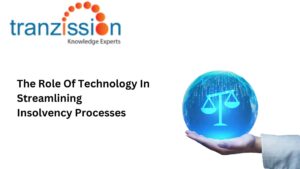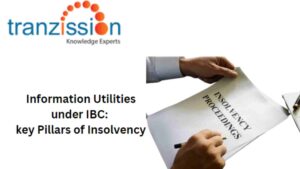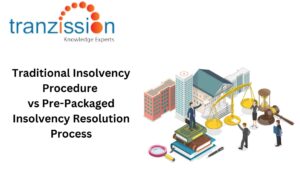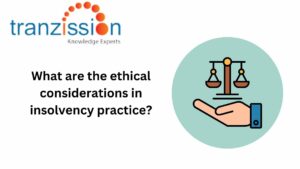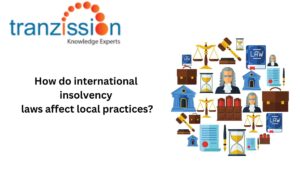
Difference between insolvency professional and registered valuer
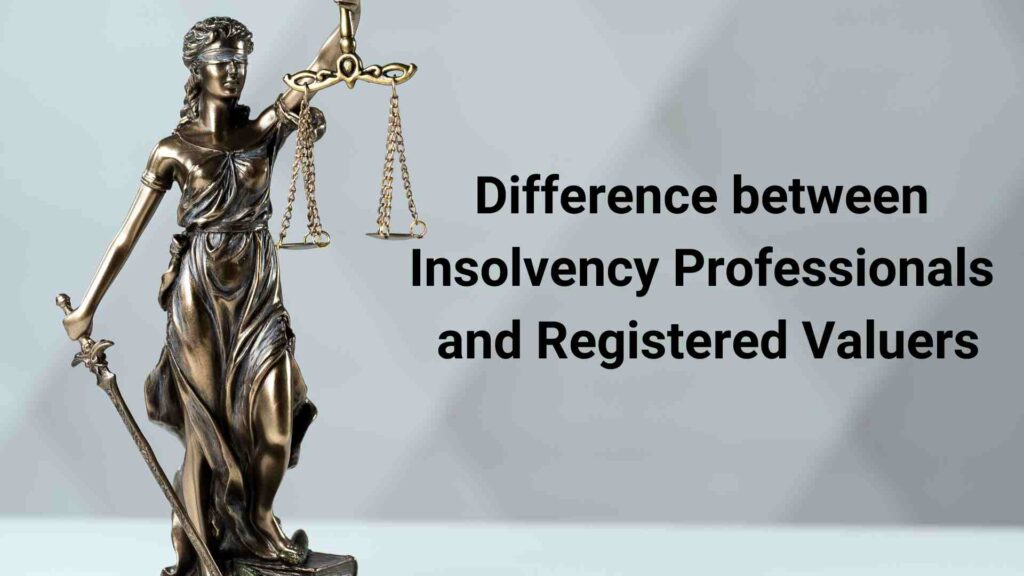
Table of Contents
In the insolvency and bankruptcy domain, insolvency professionals (IPs) and registered valuers (RVs) have crucial but distinctive roles within the insolvency process under the Insolvency and Bankruptcy Code, 2016 (hereon forward known as “the Code”). While IPs manage the overall insolvency resolution process, ensuring that it progresses in accordance with legal and regulatory requirements, RVs focus on providing accurate asset valuations, which are essential for determining the value of the debtor’s assets. The insolvency professional and registered valuer lies in their primary functions—IPs are responsible for managing the resolution process, while RVs ensure that asset valuations are precise and fair. Together, they ensure that the insolvency process is conducted in a manner that maximizes value for all stakeholders and adheres to the principles of fairness and efficiency as mandated by the Code.
Who is an Insolvency Professional
As per the section 3(19) of the Code an IP is a person who has been enrolled under section 206 with an Insolvency Professional Agency (IPA) as its member and registered with the Insolvency and Bankruptcy Board (IBBI) as an insolvency professional under section 207. In simple terms, an IP is an individual who helps manage and resolve situations where companies or individuals cannot pay their debts, but they must be properly qualified, join the Insolvency Professional Agency, and register with IBBI. IPs have an important role in re-establishing the corporate debtor’s company or managing its liquidation, with the main aim of maximising the value for creditors and other stakeholders. IPs are to abide by the standards specified under the Insolvency and Bankruptcy Board of India (Insolvency Professionals) Regulations, 2016 (hereon forward known as “IP Regulations, 2016”)
Who is a Registered Valuer?
A Registered Valuer has been defined under section 2(1)(f) of the Companies (Registered Valuers and Valuation) Rules, 2017 (here on forward known as “Rules, 2017”). Their primary focus is on providing accurate valuations of the debtor’s assets, which form the basis to all subsequent financial decisions. For instance, registered valuers in liquidation must prepare a report on the valuation of the company’s assets.This valuation report is a critical component of the documents required to initiate liquidation. The accuracy and reliability of this valuation are essential to ensure that the liquidation process is conducted fairly and transparently.
Difference between Insolvency Professionals and Registered Valuers
| Aspect | Insolvency Professional | Registered Valuers |
| Primary Role | Managing the entire insolvency resolution process | Providing accurate valuations of the debtor’s assets |
| Key Responsibilities | i) The IP has the main responsibility for initiating and managing the insolvency process. As an IRP or RP, they take under their control the debtor’s assets, assess the financial situation, and ensures business activities continues to operate, if necessary[2]. This role is required in stabilising the operations during insolvency and working towards a resolution plan. ii) The CoC is central to the insolvency resolution process, as it consists of the financial creditors, who have the authority to approve or reject resolution plans. The IP, here, is responsible for forming CoC,[3] facilitating its meetings,[4] and ensuring that all creditors views are represented. IPs assessment of the resolution plans from potential bidders is crucial as the plan must be approved by the CoC and the Adjudicating Authority, NCLT[5]. IPs must ensure that these plans comply with legal requirements and are feasible with the debtor’s business. iii) Expertise in finance, law, and management of the IP ensures that the decisions are made in the best interest of all stakeholders. The IPs advises CoC and the NCLT, to help them through the complexities of the insolvency process. iv) If the insolvency process fails, IP may be appointed as the liquidator.[6] As a liquidator, the duties of an IP is responsible for selling the debtors assets and distributing the profits among the creditors.[7] v) IPs are required to main comprehensive records of all proceedings and decisions during the insolvency process.[8] These records ensure transparency and provide an audit trail than can be reviewed by stakeholders and regulatory authorities. To ensure compliance and accountability, regular reporting to the IBBI and the NCLT is also important as per the regulations in the Insolvency and Bankruptcy Board of India (Insolvency Resolution Process for Corporate) Regulations, 2016 and Insolvency and Bankruptcy Board of India (Liquidation Process) Regulations, 2016. vi) IPs are to abide by the Code of Conduct as given in the First Schedule to the Regulations, 2016 |
i) RVs key role is to provide accurate valuations for assessing the financial status of the debtor and for making decisions about resolution plans for making decisions about resolution plans or liquidation. RVs ensure that the current situation of asset values are which helps in determining the best course of action for creditors. To confirm consistency and reliability, RVs are expected to follow the valuation standards as per the Rules, 2016. ii) RVs must provide detailed reports[9] that outline the valuation method used, assumptions made, and conclusions reached, essential for transparency throughout the insolvency process and provides a basis for decision-making by the IP and the CoC. It is essential for proper documentation so that valuations can be reviewed and audited if it necessary[10]. iii) RVs assist in both the resolution and liquidation processes by providing accurate valuations of the debtor’s assets. In liquidation, RVs help determining the liquidation value, which is essential for distributing proceeds among creditors. Their role here ensures that the asset sale is conducted at fair market value, maximising returns for creditors.[11] iv) Like IPs, RVs must comply to a Code of Conduct as explained under the Code of Conduct under Rules 3 and 4 of the Regulations, 2017 of the Registered Valuers Organisation (RVO) of the Institute of Chartered Accountants of India (ICAI) . This Code of Conduct ensures that RVs act ethically, maintain confidentiality, and avoid conflicts of interest that uphold the credibility of the valuation process. |
| Legal Framework | Insolvency and Bankruptcy Code, 2016 | Companies Act, 2013 |
| Eligibility Criteria | As per Regulation 3 of the IP Regulations, 2016, passing the Limited Insolvency Examination is mandatory for individuals to be recognised as IPs. This examination assesses the candidate’s knowledge of insolvency law, financial analysis and other relevant areas. Moving onto the next Regulation, Regulation 4, in which the title itself is ‘Eligibility’. To be eligible for registration as an IP, the candidate cannot be a minor or someone who does not live in India. They must also have the required qualifications and experience as outlined in Regulation 5. In addition to this, if the candidate has been convicted of a serious crime with prison sentence longer than 6 months, or any crime involving moral wrongdoing, they must wait 5 years after their sentence ends before they can apply they cannot register at all. Individuals who are ineligible currently insolvent, have applied or have been declared of unsound mind are ineligible. Further, the Board will assess their fitness based on factors like their past conduct, absence of legal issues, and overall competence including financial stability to be deemed the candidates as ‘fit and proper’ to an eligible IP. For entities seeking registration, they must ensure that both the entity and any of its partners or directors meet these ‘fit and proper’ criteria. If they do not, the entity cannot be registered as an IP. This ensures that both individuals and entities in insolvency work are qualified and reliable | Chapter II of the Rules, 2017 sets out the eligibility criteria for RVs, such as education qualifications, experience and the necessity of passing the Valuation Examination. The eligibility criteria is specifically provided under Rule 5. To start, an individual must pass the Valuation Examination within 3 years before applying. However, there is an exception, for those over 50 who have already completed at least 10 significant valuation projects worth Rs. 5 crores or more in the last 5 years are exempt from the exam requirement. Those who are ineligible include, minors, bankrupt individuals, non-residents and those with serious criminal convictions. If an individual has been convicted of a serious crime sentenced to imprisonment, they must wait 5 years after their sentence ends to be eligible, with a permanent ban if the sentence was for 7 years or more. It is also required that the individual be a member of a professional organisation that certifies valuers and be deemed “fit and proper”, which includes having a good reputation, no serious criminal records, and financial stability. For partnership firms seeking to become RVs, the rules are similarly strict. A firm cannot qualify if it or any of its partners are bankrupt, undergoing insolvency, or have the disqualifications mentioned for individuals. The majority of the firm’s partners practicing in India must the RVs, and at least one partner must be qualified to value the specific type of assets the firm intends to assess. |
| Focus | Ensuring the insolvency process is fair, transparent and effective | Ensuring financial accuracy that supports insolvency decisions |
| Experence | As per section 207(2) of the Code, the IBBI can set specific qualifications and experience for professionals in fields such as finance, law and management. The qualifications and experience for IPs are listed under Regulation 5 of the Regulations, 2016, wherein an individual must fulfil several requirements to become a registered IP. First, it is necessary to pass an exam called the Limited Insolvency Examination within the past year before applying. They also have to complete a required education course within 12 months after paying the application fee. It is also required that they must have the relevant work experience in one of several areas. This could mean having 10 years of experience in law after completing a law degree, having 10 years in management after obtaining a Master’s degree in Management or a similar diploma, they can qualify with 15 years of management experience after getting a Bachelor’s degree, or individuals who are chartered accountants, company secretaries, cost accountants, or advocates with 10 years of professional experience. In short, becoming an IP requires passings exams, completing coursework, and having substantial professional experience in relevant fields. | To be eligible for RV, an individual must meet specific educational and experience requirements as per Rule 6 of the Rules, 2017. They must have either a post-graduate degree from an Indian university in a ‘specified field’, with at least 3 years of experience, or a Bachelor’s degree in the same field with a minimum of 5 years of experience, or they can qualify by being a member of a professional institute established by an Act of Parliament, provided that they have at least 5 years of experience after joining the institute. The specified field refers to the specific area of expertise required for valuing the type of assets they aim to work with, such as, if someone wants to value stocks, bonds, or other financial instruments, their specified field would be financial securities valuation. |
| Appointment | IPs are appointed to manage the Corporate Insolvency Resolution Process (CIRP) or liquidation of a corporate debtor by different authorities depending on the stage of insolvency. When an insolvency application is admitted by the National Company Law Tribunal (NCLT), the NCLT appoints an Interim Resolution Professional (IRP). This appointment is based on the proposal made by the party who initiates the insolvency processes, regardless if that be the financial creditor, operational creditor, or the corporate debtor, as per section 16 of the Code. In due course, the CoC can confirm the IRP as the Resolution Professional (RP) or replace them with another IP during the first meeting as given under section 22 of the Code. The RP is then tasked with conducting the CIRP. If the insolvency resolution process is not successful, it leads to liquidation. Then the NCLT appoints a Liquidator, in which the NCLT can appoint a different IP if found necessary.[12] | RVs, on the other hand, are appointed to provide an independent and objective valuation of the debtor’s assets during the insolvency or liquidation process. Their appointment is done by the IP, who select RVs who are already registered under the Rules, 2017 based on the requirements of the case, and in accordance with Regulation 27 of the Insolvency and Bankruptcy Board of India (Corporate Insolvency Resolution Process) Regulations, 2016. The ethical and legal process of the insolvency is maintained by ensuring that both IPs and RVs are appointed based on their qualifications, expertise, and compliance to the regulatory standards. |
| Conditions of Registration | Upon registration, an insolvency professional is required to adhere to the Code of Conduct prescribed by the IBBI at all times, regardless of whether they are on or off assignments.[13] This includes maintaining professional integrity, confidentiality, and avoiding conflicts of interests as implied from section 208(1) of the Code. IPs must comply with the requirements specified by the IBBI, including payment of fees, and adherence to the IP Regulations, 2016. As per Regulation 5 of the IP Regulations, 2016, IPs must be deemed “fit and proper” by the IBBI, which includes having the appropriate qualifications and relevant experience. As per Regulation 7 of the IP Regulations, 2016, IPs must engage in continuous professional development to stay updated with changes in laws and best practices. This ensures they maintain the necessary knowledge and skills to effectively carry out their responsibilities. | When a RV is granted registration, they must adhere to several important rules such as Rule 9 of the Rules, 2017, which particularly provides for the ‘conditions of registration’. They are required to follow all relevant laws and regulations and adhere to the established valuation standards. They should only value the types of assets for which they are registered. On the chance that a RV wants to change their membership from one valuation professional organisation to another, they must obtain permission from both the organisations. They must also have a system to place to address any complaints and keep records of all their valuation work for at least three years. In a partnership, only registered assets for the specific assets should sign the valuation reports, and the valuer is personally liable for the work done by the partnership firm. It is also required to follow any additional conditions set by the Registration Authority. |
What is the Scope of Insolvency Professionals and Registered Valuers?
IPs have a broad scope which includes the assessment of the financial position of the company, partnerships, LLPs, individuals,etc. for the assurance of the smooth process of its dissolution. The main role of the IP extends to the administration of the corporate debtor’s estate, while managing assets, conducting insolvency resolution process, formulation of the resolution plans, facilitating the liquidation or restructuring process, and complying to the legal and regulatory requirements. RVs have a narrow scope, which focuses on the valuation of assets of the corporate debtor, which is important for making informed decisions about whether to pursue resolution or liquidation. RVs must consider a wide range of factors, including market conditions, the condition of the assets, and the potential future income. Every step taken by IPs and RVs is to be under the standards of the IBBI.
How Tranzission Can Help You?
Tranzission provides a platform which equip insolvency professionals and registered valuers with the essential resources and expertise needed to deliver legally sound and commercially viable outcomes. Our platform can help insolvency professionals and registered valuers navigate the challenges with ease. Tranzission’s commitment to innovation and excellence ensures that professionals can meet the demands of their roles with unparalleled efficiency, accuracy, and compliance. Our commitment to ongoing support and continuous improvement ensures that insolvency professionals and registered valuers are always prepared with the knowledge and tools they need to address the evolving challenges of the insolvency field.
Conclusion
To summarise, the roles of insolvency professionals and registered valuers are independent and important to the successful resolution of insolvency cases under the Code. By working together, these professionals help manage the complexities of insolvency and bankruptcy to guarantee that the process is both legally compliant and fair for all the involved parties. For instance, the valuation reports prepared by the RVs provide important information to IPs, enabling them to make decisions regarding the resolution or liquidation of the debtor. As the insolvency process becomes more intricate, the expertise of these professionals becomes more indispensable. With platforms like Tranzission offering the appropriate tools and resources, IPs and RVs are better equipped to handle the challenges of their roles so that the insolvency resolutions are legally sound. The combined efforts of IPs and RVs are important in maintaining the integrity and effectiveness of the insolvency and bankruptcy framework in India.

